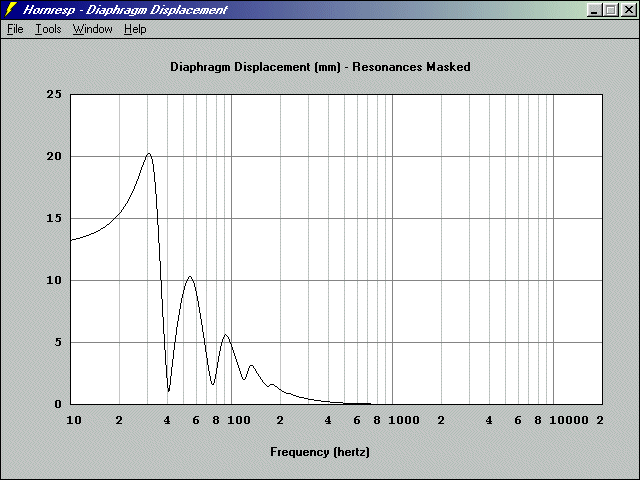| Excursion plot [message #29629 is a reply to message #29628] |
Fri, 16 September 2005 00:26   |
 |
 Wayne Parham
Wayne Parham
Messages: 18985
Registered: January 2001
|
Illuminati (33rd Degree) |
|
|
Here's another way of looking at it. The excursion chart shown below is of a very large basshorn, one that is tuned to operate above 30Hz and that has plenty of mouth area to provide good response without ripples in halfspace, even if only one horn is used. In short, it's a no compromise design. It is also huge, about 40 cubic feet.
Notice how overall excursion is reduced by the horn, but also how there are excursion peaks throughout the passband, with the maximum being right at horn cutoff. This particular horn uses drivers that have fairly long throw, so they aren't at their mechanical limits even at the peak. But still, you see the general trend. Now imagine if the horn were made as small as possible. Path area must be made small, so response is now compromised, being a series of deep ripples. Corner loading really helps in this regard. In fact, you probably would consider corner loading a requirement of such a device. Even so, the low frequency cutoff must be made higher, because there just isn't enough room inside the box to support a long path length. That means the excursion peak is shifted up, well into the passband. As you can see, the biggest requirement is that the woofer have good excursion capability. The horn just isn't able to load the driver down low. Don't misunderstand me. I think Gar's horn is probably good down to about 50Hz. When corner loaded, it might be just fine to augment say a single driver speaker or something that needs help below 100Hz. It could extend bass an octave below that. But if its application is to be used under 60Hz, it's being used primarily in the range where it is a direct radiator anyway. So it makes some sense to use a cabinet that is better suited for that frequency range, using the volume to make an alignment that works well to 20Hz. With 3ft3, that suggests a vented box tuned to 20Hz and a driver that can support it. Using a woofer with limited displacement just doesn't make sense in a sub, horn loaded or not. I'd rather have a direct radiator with some surface area and excursion than a physically small basshorn with a smaller driver. It will just plain run out of gas. The one possible exception is ultra-low power systems that won't see more than a watt or two. So my conclusion is this: If you want to make a basshorn sub, make it big or don't make it at all. A midbass horn can be made smaller. Other cabinet styles can be made smaller too. But basshorn subs need size. There's no substitute for cubic inches.
|
|
|
|
|
|
|
|
|
|
|
|
|
|
| Re: Not so fast there, excursion breath... [message #29635 is a reply to message #29634] |
Sat, 17 September 2005 02:32   |
 |
 Wayne Parham
Wayne Parham
Messages: 18985
Registered: January 2001
|
Illuminati (33rd Degree) |
|
|
No offense there Bill, I'm sure the small T18 does a good job above 50Hz. But as your graph shows, excurson rises rapidly under 50Hz. So what that means is that the box is essentially a direct radiator below 50Hz. My point is there are better ways to optimize a system for operation below 50Hz than a 3ft3 horn.The best 3 cubic foot subwoofer implementation, in my opinion, is to use the entire cabinet volume to provide an alignment that's optimized for the low frequency range, not 50Hz and up. One can then use a driver with greater displacement too, one with more radiating surface area and greater excursion capability. With a horn cabinet, much of the box is used to provide space for the flare, and the rear chamber is then necessarily pretty small. That's what is doing the work here under 50Hz - The sealed box of the rear chamber. So the alignment is not optimized for subwoofer operation, at least not under 50Hz.
|
|
|
|
| Re: Not so fast there, excursion breath... [message #29636 is a reply to message #29635] |
Sat, 17 September 2005 09:43   |
 Bill Fitzmaurice
Bill Fitzmaurice
Messages: 335
Registered: May 2009
|
Grand Master |
|
|
|
It is a direct radiator below 40 Hz, to be precise. That's not a matter of contention. It doesn't matter. What matters is that you have a 3.3 cu ft box capable of 90dB/watt SPL at 30Hz at a total build cost of less than $100. That and that alone was the design goal, and having achieved it I'm well satisfied. So are the vast majority of the builders of this cab who were able to build it, and buy an amp to drive it, for no more than the driver cost alone of most direct radiators capable of 90dB/30 Hz sensitivity in 3.3 cu ft. The fact that it totally blows away direct radiators where it is operating in horn mode is frosting on the cake.
|
|
|
|
|
|
|
|







